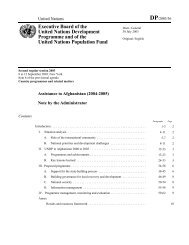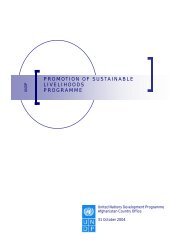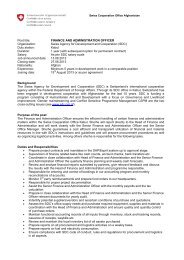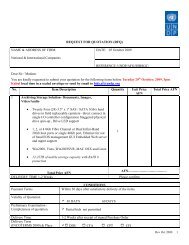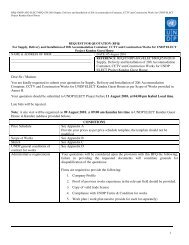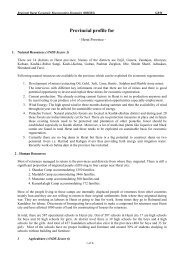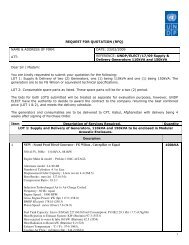E N S W - Human Development Reports - United Nations ...
E N S W - Human Development Reports - United Nations ...
E N S W - Human Development Reports - United Nations ...
You also want an ePaper? Increase the reach of your titles
YUMPU automatically turns print PDFs into web optimized ePapers that Google loves.
human well-being. Populations in large cities,<br />
for example, typically report high income per<br />
capita, but they also have high levels of crime,<br />
pollution and traffic congestion. In rural areas,<br />
farming households may see income grow while<br />
lacking a village school or health centre. Initial<br />
conditions have considerable influence on the<br />
pace of countries’ current and future development.<br />
Nonetheless, they are not the only things<br />
that matter (box 3.1).<br />
In fact, the links between economic growth<br />
and human development have snapped several<br />
times. The 1996 <strong>Human</strong> <strong>Development</strong> Report<br />
identified six unwelcome types of growth: jobless<br />
growth, which does not increase employment<br />
opportunities; ruthless growth, which<br />
is accompanied by rising inequality; voiceless<br />
growth, which denies the participation of the<br />
most vulnerable communities; rootless growth,<br />
which uses inappropriate models transplanted<br />
from elsewhere; and futureless growth, which<br />
is based on unbridled exploitation of environmental<br />
resources. 6<br />
What accounts for the superior generation<br />
of growth and its conversion into human<br />
development? What are the policy lessons<br />
from the diverse human development experiences<br />
of these countries? Indeed, what are<br />
the drivers of transformation? This chapter<br />
identifies three:<br />
• A proactive developmental state.<br />
• Tapping of global markets.<br />
• Determined social policy innovation.<br />
These drivers are not derived from abstract<br />
conceptions of how development should work;<br />
rather, they are demonstrated by the transformational<br />
development experiences of many<br />
countries in the South. Indeed, they challenge<br />
preconceived and prescriptive approaches: on<br />
the one hand, they set aside a number of collectivist,<br />
centrally managed precepts; on the<br />
other hand, they diverge from the unfettered<br />
liberalization espoused by the Washington<br />
Consensus.<br />
These drivers suggest an evolution towards a<br />
new approach, in which the state is a necessary<br />
catalyst that pragmatically adjusts its policies<br />
and actions in line with new realities and the<br />
challenges of global markets. This new perspective<br />
recognizes that development does not<br />
happen automatically and that transformation<br />
cannot be left to markets alone. Instead, the<br />
This chapter identifies<br />
three drivers of<br />
transformation: a<br />
proactive developmental<br />
state, tapping of global<br />
markets and determined<br />
social policy innovation<br />
BOX 3.1<br />
History and initial conditions matter, but they are not destiny<br />
“Initial conditions” have profound impacts, as certain characteristics are<br />
not only difficult to change, but also often perpetuated by institutions and<br />
policies. In societies that began with high inequality, elites can establish a<br />
legal framework that locks in their influence, which in turn enables them to<br />
maintain high inequality to their benefit. Take, for example, the Americas,<br />
where three distinct types of colonies took shape in the 1700s, depending<br />
on the initial conditions of soil, climate and native inhabitancy.<br />
In the Caribbean, soil and climate made colonies suited for the production<br />
of large-scale lucrative commodities. The distribution of wealth<br />
and human capital was extremely unequal, advantaging the elite who<br />
could assemble large companies of slaves. In Spanish America, abundant<br />
in minerals and natives, authorities distributed land resources to<br />
the Spanish colonists. Elites served the Spanish crown and maintained<br />
their status after independence. Income inequality persisted across racial<br />
lines, with ownership of large tracts of land being a requirement for<br />
citizenship. In Peru today, as in many other countries, severe horizontal inequalities<br />
persist between indigenous populations and those of European<br />
descent. In the northern parts of the Americas the native population was<br />
not abundant, and soil and climate did not lend themselves to economies<br />
of scale. Thus, there was reliance on labourers of European descent with<br />
high human capital and more equal distribution of wealth. Because of<br />
abundant land and low capital requirements, most adult men operated as<br />
independent proprietors.<br />
Haiti today is the poorest country in the Western Hemisphere. On the<br />
eve of its revolution in 1790, it was probably the richest country in the<br />
New World. Similarly, after the Seven Years War between the British and<br />
the French (1756–1763), the British debated whether to take Canada or<br />
Guadeloupe as reparation. Several centuries later the former proved to be<br />
more successful than other economies in the hemisphere.<br />
Yet history and initial conditions are not insurmountable barriers. About<br />
half the progress in development, measured by the HDI, over the past 30<br />
years is unexplained by the initial HDI value in 1980. Countries that start at<br />
a similar level—such as India and Pakistan, Chile and Venezuela, Malaysia<br />
and the Philippines, or Liberia and Senegal—have ended up with different<br />
outcomes. As the 2010 <strong>Human</strong> <strong>Development</strong> Report argued, if countries<br />
with similar starting points go on divergent development paths, but average<br />
global achievements have not changed, we can infer that it is national forces<br />
policies, institutions, social context and idiosyncratic shocks that drive<br />
national development outcomes. No country remains a prisoner of history<br />
for long if it wants to break out.<br />
Source: Engerman and Sokoloff 2002; Hoff 2003; Thorp and Paredes 2011; UNDP 2010a.<br />
Chapter 3 Drivers of development transformation | 65




